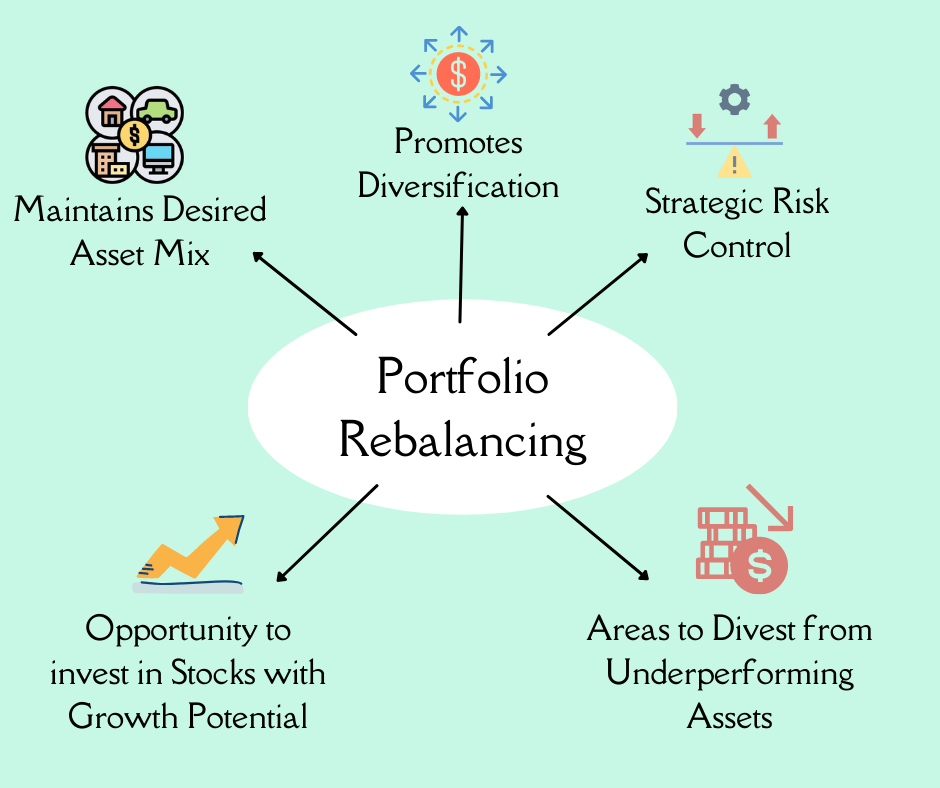What is Rebalancing and How Does it Work?

If you are one of those investors who invest their money and plan to forget about them until retirement, then you should consider understanding rebalancing and the process of doing it. Moreover, in case you have a habit of checking your portfolio regularly, then too, you should know how to do it more efficiently to optimise overall returns.
This article aims to explain portfolio rebalancing, the types of rebalancing strategies, why you should do it, and how it works.
So, let’s get started!
Understanding Rebalancing
Rebalancing refers to divesting your money from the underperforming assets or those assets that have generated your desired returns (or assets that have met your goal) and re-investing the same money into the stocks or securities that have the potential to grow so that you can maintain your desired asset mix.
In other words, rebalancing is understood as reallocating your investments into the asset mix that you originally targeted to have.
For example, you targeted an asset mix of 60:40 where 60% of your total investments go into equity and balance 40% in debt instruments. After one-year, equity stocks might outperform and constitute 80% of your total assets. In comparison, the debt securities may face a downturn and count only for 20% of total investments at the year-end.
The portfolio rebalancing considers selling equity stocks and buying more debt instruments to return to the original mix of 60:40.
Types of Rebalancing Strategies
Although the most common rebalancing strategy is to regularly review the portfolio, other types of strategy consider rebalancing with a threshold or a combination of time and threshold.
Let’s see what kind of rebalancing strategies one could consider.
Calendar Rebalancing/Periodic Rebalancing
Under the calendar rebalancing strategy, you have to review your portfolio at a fixed period every time, e.g., semi-annually, annually, or so.
Upon review, you may have to buy or sell some securities to rebalance the portfolio to the same asset mix basis on which you had invested while setting your goals.
Tolerance Band Rebalancing
In this strategy, you decide a threshold for rebalancing your portfolio beyond which you will consider rebalancing.
For example, if you set an equity threshold of 30% and the value of your equity investments increase or decrease beyond 30%, you may consider rebalancing your portfolio.
Hybrid Strategy
The hybrid strategy considers the time and proportion threshold, where you have to review your portfolio at a fixed interval to check if the asset allocation has moved beyond the specified limit.
Why Should You Rebalance Your Portfolio?

- Rebalancing ensures diversification of your portfolio as the portfolio is constantly revisited to treat the over and underperformance of the investment instruments.
- It ensures strategic risk control since the risk of any sudden downturn of the instruments is timely addressed by rebalancing the portfolio.
- Your investment goals and desired asset mix are maintained and taken care of when you consider rebalancing.
- It allows you to invest in assets that have growth potential.
- It also allows you to explore areas to divest from underperforming assets.
How is Rebalancing Done?
- Target an Asset-mix
Considering your financial goals, have a predetermined asset mix for your portfolio and invest your money accordingly.
- Pick your Rebalancing Strategy
Once your money is invested, you need to decide how to revisit your portfolio and rebalance based on periodic or threshold rebalancing strategies.
- Perform Rebalancing
Rebalance your portfolios based on your desired rebalancing strategy; you may also consider switching the strategy from periodic to tolerance based strategy or vice-versa.
- Review Rebalancing Costs
It is also essential to consider rebalancing costs such as exit loads, tax on capital gains, and brokerage costs.
The Bottom Line
Not everyone does rebalancing or is required to rebalance the portfolio. Still, if your investment goals are such that you have a predetermined asset mix to follow, you are recommended to have a rebalancing strategy.
It allows the investor to maintain an asset mix, while also preventing any shocks related to the downturn of the portfolio.
